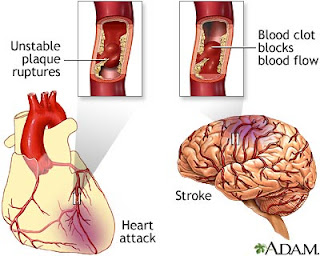A stroke, previously known medically as a cerebrovascular accident (CVA), is the rapidly developing loss of brain function(s) due to disturbance in the blood supply to the brain. This can be due to ischemia (lack of blood flow) caused by blockage (thrombosis, arterial embolism), or a haemorrhage (leakage of blood). As a result, the affected area of the brain is unable to function, which might result in an inability to move one or more limbs on one side of the body, inability to understand or formulate speech, or an inability to see one side of the visual field.
A stroke is a medical emergency and can cause permanent neurological damage, complications, and death. It is the leading cause of adult disability in the United States and Europe and the second leading cause of death worldwide. Risk factors for stroke include old age, hypertension (high blood pressure), previous stroke or transient ischemic attack (TIA), diabetes, high cholesterol, cigarette smoking and atrial fibrillation. High blood pressure is the most important modifiable risk factor of stroke.

Stroke Nursing Assessment
- Changes in level of consciousness or responivitas as evidenced by the movement, refused to change its position and response to stimulation, oriented to time, place and person
- Whether or not a volunteer or involuntary limb movements, muscle tone, posture, and head position.
- Neck stiffness.
- The opening of the eyes, the comparative size of the pupil, and pupil reaction to light and ocular position.
- The color of the face and extremities, skin temperature and humidity.
- The quality and frequency of pulse, respiration, arterial blood gases as indicated, body temperature and arterial pressure.
- Ability to speak
- The volume of fluid you drink and the volume of urine released every 24 hours.
Stroke Nursing Diagnosis
- Impaired verbal communcation
- Impaired physical Mobility
- Anxiety [specify level]
- Deficient knowledge regarding diagnosis, prognosis, and treatment options
- Risk for disturbed Body Image
- Risk for ineffective Sexual Pattern
- Self-Care Deficit [specify]
- Disturbed Sensory Perception (specify)
- Disturbed Thought Processes
- Risk for Injury/Trauma


